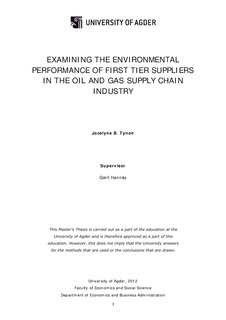| dc.description.abstract | The increasing interest in environmental sustainability and supply chain performance is
creating a pressure on firms to pay more attention to their environmental footprints. This
pressure is felt more in high polluting industries; therefore, these companies tend to pass these
pressures to their suppliers. Thus, environmental performance of supply chains has become
an extension of the individual firms’ performance and a reflection of their environmental
commitment to the natural environment.
The objective of this Master Thesis is to examine the environmental performance of upstream
companies in the oil and gas supply chain. Using the Uppsala model and the resource-based
view (RBV) of the firm as a theoretical foundation, the firm resources and capabilities, its
environmental commitment, and the degree of environmental collaboration are identified as
three potential drivers for environmental performance. The interaction between environmental
commitment and environmental performance is influenced by the environmental regulations
that act as a moderator for compelling environmental behavior, and the need for incentives as
a motivator for self-regulating. The study is exploratory in nature and based on interviews
and online survey with six companies in the offshore oil and gas industry. The aim is to
examine the path process between the variables and their implication on environmental
performance.
The findings reveal that a proactive environmental commitment has a direct influence on
setting goals and priorities manifested in the firm’s actions. Green purchasing activities, to
include selecting, evaluating, and monitoring suppliers are central in communicating an
environmental commitment and conducing a better environmental behavior in the supply
chain. The findings also show that commitment acts as a driving mechanism for
environmental collaboration and investment decisions to develop appropriate environmental
resources and capabilities. The valuable resources and capabilities of the firm are found to
have specific advantage in capturing opportunities, creating sustainable products, and
responding to customers’ environmental requirements. Environmental collaboration is found
to be task specific and emphasizes more collaboration with customers than with the supplier.
In addition, it is regarded as inhabited with relational risks, therefore, it is only exercised to
the extent it does not compromise competitiveness.
iii
The findings also show that environmental regulations are perceived complicated and lacking
guidance in the design and use of environmental indicators. They are also seen as open for
broad interpretation and inefficient in resolving issues of environmental responsibilities. The
difference in the interpretation and application of environmental standards across countries
challenges the competitiveness of companies when competing in more relaxed regions. In
addition, the findings show that environmental commitment is focused on the business areas
and on locations that are subject to stronger control. Therefore, the findings imply that
regulations would yield better results if they are applied with tighter control.
The introduction of an incentive approach is seen as a positive motivator to reinforce
environmental commitment. Incentives help companies preserve their competitiveness in the
international market without compromising their sustainable performance. Supplier’s
incentives are useful in fostering a deeper commitment to a proactive environmental
performance. However, the findings reveal that companies are not interested in committing
efforts to the suppliers’ development programs. Based on these findings, the study discusses
some implications regarding green purchasing decisions and activities; in addition to
implication concerning environmental regulations and controls. The study also highlights
limitations encountered and postulate recommendation for future research. | no_NO |
